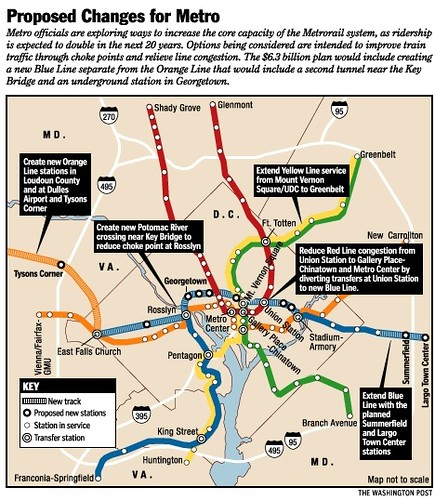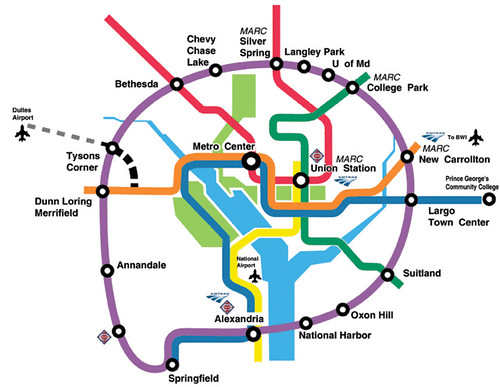Weak discourse on "congestion" by Washington Post columnist
Photos taken of 14th Street, looking south, from Florida Avenue NW, showing minimal traffic, in the early afternoon.
This of course is nothing new, but is still damnably frustrating. See "Washington area has a real chance to reduce traffic congestion."
I would argue the best investment the region can make in transportation is in sustainable mobility, not roads.
Robert McCartney, the columnist does acknowledge this, but the column is about what he sees as the four most important road projects for the area: widening of I-66; I-395; and I-495; and the creation of the Bi-County Parkway in Prince William and Loudoun Counties in Virginia (I'm surprised he didn't suggest widening the Baltimore-Washington Parkway and an Outer Beltway or at least another east-west crossing between Montgomery County Maryland and Northern Virginia), as well as paying for subway expansion.
His focus on roads comes because:
Today, with people driving less and development planned more intelligently, we have a shot at expanding road capacity without contributing to the problem.
I wrote about the reported reduction in commute times too ("Road building, induced demand, and tolls") and made a point that seems to have eluded the columnist.
The most recent additions to road miles are tolled. So maybe these roadway expansions are improving trip times but not "inducing" demand, because each trip on the roads costs money. I don't see freeway expansions without tolls as being capable of not inducing demand.
But there isn't enough data to conjecture very much about it, especially because the reported data that the Post is reporting is data only on automobile trip and for a short period of time.
That being said, the column misleads as does most reporting on congestion. Mostly, congestion is a suburban phenomenon. It's produced by a mobility paradigm that is automobile dependent.
The best way out of congestion is to produce more places that aren't automobile dependent, to reduce the compulsion to drive, so that walking, biking, and transit are efficient and the most optimal way to get around.
Yes there are streets in DC that are congested--mostly the main commuter entry and exit arteries. Although some places here and there are choke points because of configuration and what we might call UTS--unintelligent transportation system--issues.
But for the most part, especially in the core, DC is not congested. To me it's proof that the Walking City urban design works and WMATA--for all its foibles--especially the subway system, works particularly well for the center city.
So that means that for many hours of each day, it's not that bad to get around, especially if you aren't doing it by car. (Go bike!)
For me the biggest DC transportation priority ought to be the expansion of subway service:
 1. the so called separated blue line (now the Silver Line), which would add a Potomac River crossing, serve Georgetown, parallel downtown in part, add another line serving Union Station--absolutely necessary to support Amtrak's planned growth as well as local "commuter" railroad expansion, and depending on the routing, could serve other parts of the city in the northeast quadrant would be my biggest priority.
1. the so called separated blue line (now the Silver Line), which would add a Potomac River crossing, serve Georgetown, parallel downtown in part, add another line serving Union Station--absolutely necessary to support Amtrak's planned growth as well as local "commuter" railroad expansion, and depending on the routing, could serve other parts of the city in the northeast quadrant would be my biggest priority.2. But considering the creation of a separated yellow line going up Georgia Avenue is high on my list too.
In either case, funding for this would likely come from allowing a height increase for buildings in the central business district. Otherwise the city probably doesn't have enough money to pay for it, and it's not like these days the Federal Government will step up and fund it.
For the suburbs it would be to:
 3. Build the Purple Line light rail line between Bethesda and New Carrollton in Prince George's and Montgomery Counties.
3. Build the Purple Line light rail line between Bethesda and New Carrollton in Prince George's and Montgomery Counties.(At the same time Prince George's County needs to reposition its planning and development paradigm toward transit proximity and connectivity (see "Another lesson that Prince George's County has a three to five year window to reposition based on visionary transportation planning " and "Frustration #3: the talk about transit oriented development and Prince George's County ".)
4. Merge MARC and VRE into one metropolitan area railroad passenger service, and plan for expansion of service and the creation of additional lines. (Although this will also help the center city and actually, DC should join in with Maryland and Virginia to support such a service.)
5. Begin expansion planning of the Purple Line on the southwest from New Carrollton to Alexandria Virginia (thereby serving National Harbor) and on the northwest from Bethesda to Fairfax County.
6. Think about routing a separated yellow line subway beyond DC into Montgomery County. New Hampshire Avenue would be the best routing for Montgomery County, but not for DC.
It could be possible for DC to pursue a separated yellow line up Georgia Avenue and then into MoCo, while a separate line could serve Montgomery County from White Oak and connect into the city at Fort Totten and follow the green line routing. (Additional stations along New Hampshire Avenue in DC doesn't accomplish for the city, with the exception of the possibility of a station serving part of the Armed Forces Retirement Home campus, if part of it got developed.)
I'd love to see a Washington Post columnist write about these issues.
Labels: car culture and automobility, media and communications, sustainable transportation, transportation demand management, transportation planning





9 Comments:
all abandoned rail rights of way should have trains running on them. In Europe you would be hard pressed to find abandoned rail spurs which are rather embarassingly common here in the USA since we have let so much of this slide in the part 60 odd years of auto reliance and hegemony. The WaPO is not a local newspaper and their reporters have zero alliegiance to the city- nor to the area for that matter. that silly anti-DC food/restaurant article just yesterday was another example of someone who really has no idea of DC's heritage spouting and foaming off at the mouth about things he does not understand. These people make me sick and tired. Yes- a separated Yellow line and Blue line and even a Borwn line- Anacostia could use more subway service and the old Chesapeake Beach line should be revived- all of this is good thinking but outside the scope of the mypoic minded leadership and media that runs this area and city. MARC and VRE should run on weekends and be integrated /joined up. All good. This post writer is no doubt suburban and probably older and not given to ways to get around other than the car.
a Chesapeake Beach line and or a commuter line running to Anapolis would be a smart rail line to build. I know all kinds of people who always tell me they would use it if it was to be built. Our leadership in Maryland and in DC is so apathetic and lackluster I doubt that any of them are even remotely thinking of answers like these.
Good article and comments.
One thing missing (which is currently in active planning and construction) is the interim solution of streetcars. I imagine it was left out because they are more about moving people in-town. However, if they help mitigate SOV trips, even if it is only within the city (or short distances city to suburb or vice versa) that helps roadway congestion also.
agreed, absolutely. But I still wish the city would have pursued the separated blue line over the streetcar.
in any case, the coming operation of the streetcar on H Street is very exciting and will have some incredibly positive impact on the retail mix there over the next 5-8 years.
1. I'm sure the various highway projects mooted would have a larger bill than a seperate blue line.
2. We may be reaching the end of the "tolling" era in VA. Beltway lanes have been a disaseter and I would not be surprised if bk is an option.
3. Related to #1, in this region is is more cost effective to invest in the core (800K-1M people) than try and build cities out in Fairfax or North Bethesda.
4. What is missing your traffic analysis is that jobs in DC are all downtown, albeit that "downtown" is enourmous thanks to lack of high buildings. West End to Navy yard now.
5. DC has an interest in attracking residents, not jobs. I'd say they need to work with VA and MD closley to turn Rosslyn, Betheda and SS into real job centers so DC residents can work there. Building on #1, how can transit leverage that. Say a metro line from Rosslyn to Bethesda.
Commercial property tax is a significant source of the budget. I hate to admit I never have read a CAFR for the city, but Downtown generates about 20% of the city's budget.
It would be more if the buildings were taller (but not as spread out).
I think the city needs to continue to attract and retain commerce as well as residents...
As businesses shrink their workforces as space/employee, location in DC may end up being more valuable (like my NSF argument re Wilson Blvd.).
Interesting scenarios in any case.
Note that DC and residents is economically positive only because we capture all the local income tax...
(20% of the locally generated revenue is what I meant to write.)
I agree that I would rather see the separated blue line... but you can't fault DC government for funding and actively pursing some major transit projects.
Right, and in fact I'd suspect commercial is a lot higher. A friend does the commerical stuff for the CFO's office and the number he gave me was a bit higher.
The larger point is the unique tax structure (can capture residents with high income, not commuters) gives an incentive to DC to move towards condos, not office -- which is what Williams realized 10+ years ago.
That beign said, we need to have job centers inside the beltway -- no matter what people say, a reverse commute from DC to Tysons on silver line is not going to be easy or fun.
In fact a lot of people I know moved to DC because the reverse commute -- by car -- is much easier to suburban jobs.
(Also the car tax allows you nicer wheels than Virginia. Easy source of revenue.....)
Post a Comment
<< Home